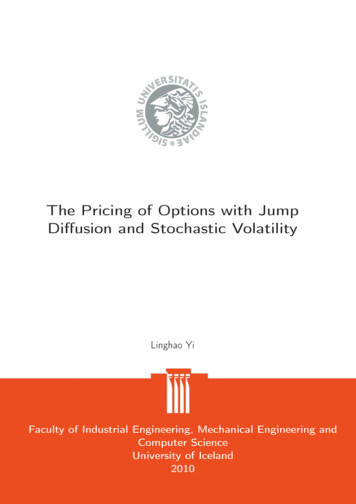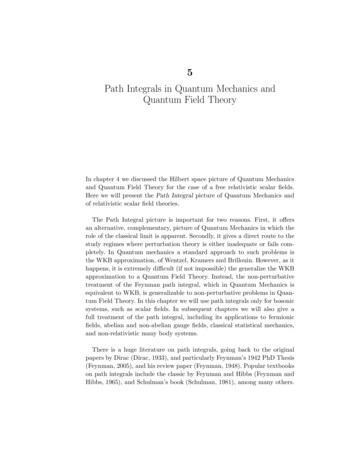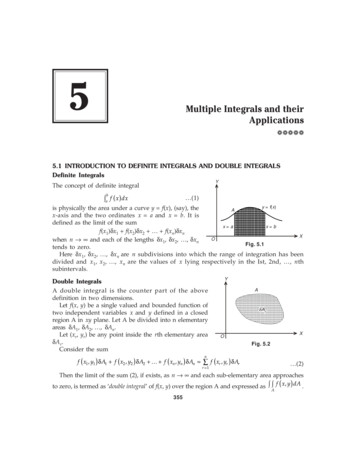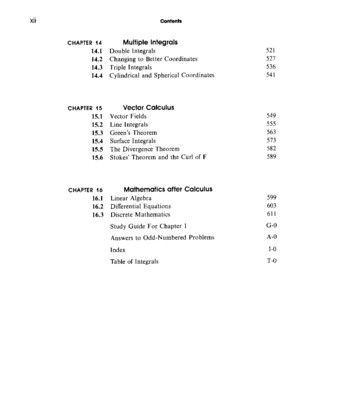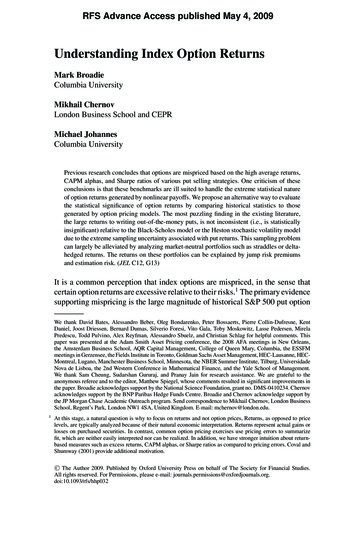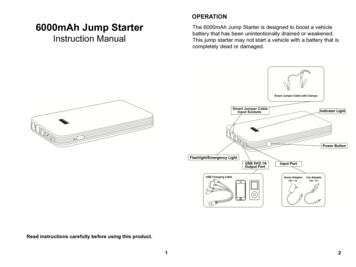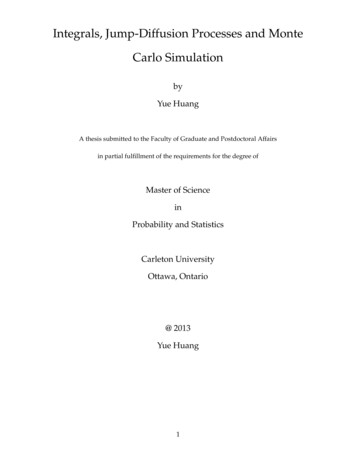
Transcription
Integrals, Jump-Diffusion Processes and MonteCarlo SimulationbyYue HuangA thesis submitted to the Faculty of Graduate and Postdoctoral Affairsin partial fulfillment of the requirements for the degree ofMaster of ScienceinProbability and StatisticsCarleton UniversityOttawa, Ontario@ 2013Yue Huang1
iiAcknowledgementsI want to give my special appreciation to my supervisors Dr. Donald Dawson andDr. Yiqiang Zhao, for their gentleness, their selfless warm help and encouragement,which touch and ignite my passion yet remembering to be humble and thankful inpursuing the scientific spirit. I would also like to give thanks to my parents, for theirsupport, always almost anytime.
iiiAbstractThis master thesis is to fulfill the curiosity in how special characteristics of Brownian motion motivate and distinguish the development of Itô calculus from the closerelative - Stieltjes integral. Therefore, firstly we will see the general Stieltjes integral theories and how the concept of p-variation plays a determining role in Stieltjesintegrability and the case where the fractional Brownian motion can also be an integrator given certain Hurst parameters under the Stieltjes scope in terms of Young’sextension of p-variation theory. And then we will give a tour of the distinctive traitsof Brownian motion including its property on p-variation as well as the Big-3 properties, namely, nowhere differentiability, unbounded variation, positive quadraticvariation and how they mark the necessity to evolve a new Itô integral on integrator Brownian motion from the standard Stieltjes integral. Subsequently, we expandthe integrator in Itô integral from Brownian motion with continuous path to Itô integral as a continuous diffusion process and further to jump-diffusion processes.Thereafter, we see how these new stochastic processes, all of which, results of thenewly defined stochastic integrations, play a role in modelling financial assets asstochastic differential equations and in the end how sample paths of these stochastic processes can be generated using simulation methods and examplify the factthat Jump-Diffusion models are improvements from classical Black-Scholes-Mertonmodel to incorporate the fat tail effects usually exhibited in empricial financial data.
oduction11.1Gaussian Process . . . . . . . . . . . . . . . . . . . . . . . . . . . . . .31.2Brownian Motion . . . . . . . . . . . . . . . . . . . . . . . . . . . . . .31.3Fractional Brownian Motion (fBm) . . . . . . . . . . . . . . . . . . . .31.3.1Comparison with standard Brownian motion . . . . . . . . . .41.3.2Properties in terms of H: . . . . . . . . . . . . . . . . . . . . . .41.3.3Other Properties: . . . . . . . . . . . . . . . . . . . . . . . . . .41.3.4Applications: . . . . . . . . . . . . . . . . . . . . . . . . . . . .41.4Itô Process . . . . . . . . . . . . . . . . . . . . . . . . . . . . . . . . . .51.5Jump Processes . . . . . . . . . . . . . . . . . . . . . . . . . . . . . . .51.5.11.5.22iiPure Jump Process- the Building Block of Jump Stochastic Integrals . . . . . . . .5General Jump Process . . . . . . . . . . . . . . . . . . . . . . .8Introduction to Stieltjes Integral92.1Definitions and Notations . . . . . . . . . . . . . . . . . . . . . . . . .92.2Theorems on Upper and Lower Stieltjes Sums . . . . . . . . . . . . .102.3Properties of Stieltjes Integrable Function . . . . . . . . . . . . . . . .112.4Sufficient Conditions to Determine Stieltjes Integrability . . . . . . .112.4.1Theorems to Determine Stieltjes Integrability . . . . . . . . . .12The General Stieltjes Integral Theory . . . . . . . . . . . . . . . . . . .142.5.1142.5Sufficient Conditions of the Existence of a Stieltjes Integral . .
CONTENTS34vStieltjes Integral with Fractional Brownian Motion as the Integrator183.1p-variation of fBm . . . . . . . . . . . . . . . . . . . . . . . . . . . . . .183.2Theorems Concerning Stieltjes Integration on fBm . . . . . . . . . . .19Itô Integral with Brownian Motion as the Integrator204.120Brownian Motion is Nowhere Differentiable almost surely . . . . . .4.1.14.2The Impacts of Brownian Motion’s nowhere-Differentiabilityon Itô Calculus when Brownian Motion is the Integrator . . .20Brownian Motion has Non-zero Quadratic Variation Almost Surely .214.2.1The Relationship between Quadratic Variation and Differentiability . . . . . . . . . . . . . . . . . . . . . . . . . . . . . . . .4.2.2Quadratic Variation of Nowhere-differentiable Brownian Motion: . . . . . . . . . . . . . . . . . . . . . . . . . . . . . . . . . .4.34.44.54.62122Brownian Motion is a Function of Unbounded Variation Almost surely 234.3.1Functions of Bounded Variation . . . . . . . . . . . . . . . . .234.3.2Bounded Variation and Bounded Functions . . . . . . . . . . .234.3.3Bounded Variation and Monotonically Increasing Functions .244.3.4Bounded Variation and Differentiable Functions . . . . . . . .244.3.5Brownian Motion has Unbounded Variation Almost Surely .26Brownian Motion in Contrast to a Smooth Function in Standard Calculus . . . . . . . . . . . . . . . . . . . . . . . . . . . . . . . . . . . . .28Itô Integral Defined for Random Step Process . . . . . . . . . . . . . .284.5.1Definition . . . . . . . . . . . . . . . . . . . . . . . . . . . . . .284.5.2Other Properties of Itô Integral Defined on Simple Processes .294.5.3Itô Isometry . . . . . . . . . . . . . . . . . . . . . . . . . . . . .29Itô Integral Defined for General H02 Integrands . . . . . . . . . . . . .304.6.1Construction of the general Itô Integral . . . . . . . . . . . . .304.6.2Summary of the Steps to Construct the Itô Integral . . . . . . .32
CONTENTS4.6.34.756Itô Isometry . . . . . . . . . . . . . . . . . . . . . . . . . . . . .33Differences between Itô Integral and Riemann Integral . . . . . . . .33Itô-Doeblin Formula355.1Quadratic Variation . . . . . . . . . . . . . . . . . . . . . . . . . . . . .355.1.1Quadratic Variation of a Brownian Motion . . . . . . . . . . .355.1.2Quadratic Variation of an Itô Integral . . . . . . . . . . . . . .355.1.3Quadratic Variation of a continuous Itô Process . . . . . . . .375.1.4Quadratic Variation of a Jump Process . . . . . . . . . . . . . .375.2Itô Formula for Brownian Motion . . . . . . . . . . . . . . . . . . . . .385.3Itô Formula for continuous Itô Process . . . . . . . . . . . . . . . . . .405.4Itô Formula for Jump Process . . . . . . . . . . . . . . . . . . . . . . .405.5Itô Formula for Multiple Jump Process . . . . . . . . . . . . . . . . . .40Stochastic Integral with Jump-Diffusion Processes as the Integrator426.1Itô Integral with Continuous Itô Process as the Integrator . . . . . . .426.2Stochastic Integral with Pure Jump Process as the Integrator . . . . .426.3Stochastic Integral with Jump-Diffusion Process as the Integrator . .436.3.1More on Itô-Doeblin Formula for Jump Stochastic Integral . .43S.D.E. with Jumps . . . . . . . . . . . . . . . . . . . . . . . . . . . . . .466.47viJump-Diffusion Processes in Financial Applications477.1Volatility and Quadratic Variation of Diffusion Models . . . . . . . .477.1.1Concepts of Volatility in Diffusion Models: . . . . . . . . . . .477.2Some Financial Instruments: . . . . . . . . . . . . . . . . . . . . . . . .487.3Black-Scholes-Merton Model . . . . . . . . . . . . . . . . . . . . . . .507.4Modelling Asset Price using Jump Processes . . . . . . . . . . . . . .527.4.154Merton Jump-Diffusion Model . . . . . . . . . . . . . . . . . .
LIST OF FIGURESvii8Application in Monte Carlo Simulation568.1Fractional Brownian Motion Paths . . . . . . . . . . . . . . . . . . . .568.1.1Euler Hypergeometric Integrals . . . . . . . . . . . . . . . . .568.1.2Gaussian Quadrature . . . . . . . . . . . . . . . . . . . . . . .578.2Simulation of Black-Scholes-Merton Model . . . . . . . . . . . . . . .578.3Simulation of Merton Jump Diffusion Model . . . . . . . . . . . . . .608.3.1608.4Simulation at Fixed Dates . . . . . . . . . . . . . . . . . . . . .Empirical Examination of Daily Returns on Standard & Poor 500 Index 63Appendices67A Modes of Convergence67A.1 Mean Square Convergence . . . . . . . . . . . . . . . . . . . . . . . . .B Function Approximation and Convergence in L2 -Norm6768B.1 Sufficient Conditions for Convergence in L2 . . . . . . . . . . . . . . .68B.2 Function Approximation in L2 -Norm . . . . . . . . . . . . . . . . . .68C Function Approximation and Convergence in Euclidean Norm69D From Euclidean Convergence to L2 Convergence69E Adapted Stochastic Processes70Bibliography71List of Figures1Brownian Motions with almost surely nowhere-differentiable paths .252A Fractional Brownian Motion Path with H 0.3 . . . . . . . . . . .583A Fractional Brownian Motion Path with H 0.7 . . . . . . . . . . .58
LIST OF FIGURESviii4Simulation of a Black-Scholes-Merton Diffusion Process Path . . . . .595QQ Plot of a Black-Scholes-Merton Diffusion Process . . . . . . . . .596Simulation of a Merton Jump Diffusion Process using Fixed DatesScheme . . . . . . . . . . . . . . . . . . . . . . . . . . . . . . . . . . . .627QQ Plot of a Merton Jump Diffusion Process using Fixed Dates Scheme 628Log Daily Return S&P 500 Index: from 4 Jan 2000 to Aug 8 2013 . . .9Histogram of Log Return S&P 500 Index Compared to Standard Normal 6363
1INTRODUCTION11IntroductionThe objective of this thesis is to review the development of integrals for some classesof stochastic processes and their applications to finance. The reorganization of someliterature results which will be included will appear in following order. First wewill introduce those useful stochastic processes which will be showcased as Brownian motion, fractional Brownian motion in the Gaussian processes class, continuousItô processes as well as jump-diffusion processes. And then in the next chapter,we will present the Stieltjes integral, including Young’s extension to incorporatep-variation into the general Stieltjes theory. From there, we show that fractionalBrownian motion (fBm) with Hurst parameter H 21 , can also be compatible withthe p-variation requirements on general Stieltjes integration. However, as soon asH 12,which gives us a standard Brownian motion, it makes insufficient condi-tions to properly define a Stieltjes integral and that is due to special properties ofBrownian motion, which include but not limited to the equivlency of a finite p 2variation, unbounded variation, nowhere differentiability and positive quadraticvariation. Therefore, a new Itô integral is developed with Brownian motion as theintegrator, and we introduce its calculus in Chapter 4. We single out a section on asummary of the quadratic variation properties of all the stochastic processes fromBrownian motion to jump-diffusion processes and how they have a close relationship with the Itô-Doeblin formula as the ”chain” rule in Itô calculus in Chapter 5.The Itô integral extension to continuous Itô processes, pure jump processes and further to jump-diffusion processes are shown in Chapter 6. Thereafter, applicationsin modelling financial assets are presented in Chapter 7 and an examination of emprical data of Standard & Poor 500 index from 2000 January 4th to 2013 August8th as well as my own outcome in simulations using MATLAB of the Black-ScholesMerton (BSM) model and the Merton jump-dffusion model (MJD) are done in Chapter 8 and we can clearly see an improvement from the BSM model to MJD model to
1INTRODUCTIONincorporate the fat tail effects exhibited in the empirical data.2
1INTRODUCTION3Useful Stochastic Processes1.1Gaussian ProcessDefinition 1.1 A process { Xt }t T for some index set T is called a Gaussian process if andonly if for every finite set of indices t1 , ., tk T, ( Xt1 , ., Xtk ) is a multivariate Gaussianrandom variable.1.2Brownian MotionDefinition 1.2 A stochastic process B(t) is called a standard Brownian Motion or WienerProcess if it satisfies:1. B(t) starts from 0, i.e. B(0) 02. B(t) has a continuous path3. B(t) has independent and stationary increments: B(t) B(s) and B(v) B(u) are independent when s t u v B(t) B(s) d B(t h) B(s h) N (0, t s) for s, t [0, ), t s andh for t h, s h [0, )Brownian motion is a Gaussian process.1.3Fractional Brownian Motion (fBm)Definition 1.3 A continuous time centered Gaussian process BH (t) for t [0, T ], H (0, 1) is a fractional Brownian motion when:1. BH (0) 0.2. E[ BH (t)] 0, t [0, T ].3. E[ BH (t) BH (s)] 21 ( t 2H s 2H t s 2H ).
1INTRODUCTION1.3.14Comparison with standard Brownian motionfBm is a generalization of Brownian motion not necessarily with independent increments. It is a Brownian motion when H 12 .1.3.2Properties in terms of H: H 21 : Brownian motion. H 12 : Positively correlated increments, also a persistent fBm. H 12 : Negatively coorelated increments, also an anti-persistent fBm.1.3.3Other Properties:We provide more properties of fBm as discussed in Biagini, Hu, Øksendal and Zhang(2008)1. fBm has stationary increments, which means BH (s t) BH (s) d BH (t) fors, t 0,2. fBm has continuous sample paths.1.3.4Applications:fBm is applied in the modeling of many situations such as introduced in Biagini, Hu,Øksendal, Zhang (2008):1. The temperature at a specific place as a function of time.2. The level of water in a river as a function of time.3. The values of the log returns of a stock.4. Financial turbulence, i.e. the empirical volatility of a stock, and other turbulence phenomena
1INTRODUCTION55. The prices of electricity in a liberated electricity market.In cases 1 to 3, we use persistent fBm with H with H 1212and cases 4 and 5 anti-persistentwhere persistent means that the particle persist in the same directionand anti-persistent means that the particle path tends to turn back on itself as described in Sarkar (2011).1.4Itô ProcessAlmost all Markov processes other than jump processes belong to the class of Itôprocesses.Definition 1.4 An Itô process X (t) can be expressed in the form ofX ( t ) X (0) Z t0 (u)dB(u) Z t0Θ(u)du(1)where B(u) is a Brownian motion with {F (u)}u 0 being the associated filtration; (u)and Θ(u) are the adapted processes. 1RtIn ( 1), 0 (u)dB(u) is the Itô integral part, denoted by I (t),Rt0 Θ ( u ) du is the Riemann integral part, denoted as R ( t ).The detailed description will be given in Sections 4-6.1.5Jump Processes1.5.1Pure Jump Process- the Building Block of Jump Stochastic IntegralsA typical feature of a pure jump processes is that they stay constant between jumps.Types: Simple Poisson Process1 SeeAppendix E
1INTRODUCTION6 Compound Poisson ProcessSimple and Compound Poisson Process:Let N (t) be the simple Poisson. We can then define the Compound Poisson processQ(t)byNtQ(t) Q(0) [YTk YTk ], where Tk are the jump times and Y ( Tk ) are i.i.d. randomk 1variables.Note that in the special case in which YTk YTk 1 for all k Q(t) N (t). We thenhave the properties right continuous: N (t ) N (t) piece-wise constant path: Q( Tk 1 ) Q( Tk ) 0 random jump sizes. Lévy properties: Independent and Stationary Increments:– N (s t) N (s) d N (t) :The distribution of the number of increments only depends on the lengthof the time interval, but not on the start and end time– N (t s) N (s) is independent of N (s): The increments from the presentis independent from the past up to the present.Properties:1. A pure jump process has a stochastic integral representation w.r.t. a pure jumpprocess.2. Because the simple Poisson has Lévy properties, so does the Compound Poisson, that is: Q(t s) Q(s) d Q(t)
1INTRODUCTION7 Q(t s) Q(s) is independent of Q(s).Construction:NtQ(t) Yii 1Yi : i.i.d. random variable with probability distribution v(dy) on RN (t) : Simple Poisson Process; Q(t) share the same jump times as N (t)dQ(t) Q(t) Q(t ) Yi when t { T1 , ., TN (t) }, where Tk are the jump timesand 0 otherwise.Expression of the Compound Poisson Process as a Jump Stochastic Integral:1. Simple N (t): from a sum of jump sizes 1 to a Stochastic IntegralN (t) kN t 1 I[Tk , ) (t) ; Tk is the jump times for k 1, .N (t)RtRtRt 0 1 dNt 0 jump sizes dNt 0 ( N (s) N (s )) dN (s).2. Compound Q(t): from a sum of random jump sizes to a Stochastic IntegralQ(t) kN t 1 Yi ; Yi is the random jump sizes and independent of N (t)RtRtRtQ(t) 0 Q(s) Q(s )dN (s) 0 jump sizes dN (s) 0 dQ(t).Jump Stochastic Integration Produces Jump Process:1. The stochastic integration w.r.t. a simple Poisson process produces a ComN (t)Rtpound Poisson process: 0 φ(s) dN (s) φ( Tk ) ; where φ(s) is a stochask 1tic process.2. The stochastic integration w.r.t. a compound Poisson process produces againa compound Poisson process:NtRtφ(s)dQ(s) φ( Tk )( Q( Tk ) Q( Tk )); where Tk are the jump times0k 1of the Compound Poisson Q(t) and ( Q( Tk ) Q( Tk )) are the jump sizes ofQ ( t ).
1INTRODUCTION1.5.28General Jump ProcessDefinition 1.5 A general jump process X (t) can be written in the form of ([21])X ( t ) X (0) R ( t ) I ( t ) J ( t )(2)Rtwhere R(t) is a Riemann integral 0 Θ(u)du with Θ(u) being an adapted process, I (t)Rtis an Itô integral 0 Γ(u)dB(u) with Γ(u) being an adapted process and the integrator isa Brownian motion B(t) and J (t) is an adapted, right-continuous pure jump process andJ (0) 0.We denote the continuous part X (0) R(t) I (t) as X c (t), and we permit only finitelymany jumps over a finite time interval for J (t).Properties:1. A general jump process X (t) is right-continuous, which means lim X (s) s tX (t), X (t) is the value after the jump while X (t ) X (0) R(t) I (t) J (t ) is the value before the jump. Hence, the jump size X (t) X (t) X (t ) J (t) J (t) J (t ).2. Any jump process can be expressed as a stochastic integral with jump processas the integrator.3. A jump process is an Itô process.
2INTRODUCTION TO STIELTJES INTEGRAL29Introduction to Stieltjes Integral2.1Definitions and Notations f ( x ) is defined on a closed interval [ a, b] ; α is a function not necessarily continuous; α( x ) is a monotonic increasing function on [ a, b]; [ a, b] is divided into partitioned intervals: [ xi , xi 1 ) ; x0 a ; xn b Mi : the lub of f(x) in [ xi , xi 1 ); mi : the glb of f(x) in [ xi , xi 1 ) αi α( xi 1 ) - α( xi ) Pn denotes a partition of [ a, b] such that Pn { a x1 x2 . xn b} Mesh Π( Pn ) is the maximum of the size of the partition sub-intervals such thatΠ( Pn ) max xi 1 xi in 1 Upper Stieltjes Sum is defined as U ( Pn , f , α) Mi αii 0n 1 Lower Stieltjes Sum is defined as L( Pn , f , α) mi αii 0 Upper Stieltjes Integral is defined asRb Lower Stieltjes Integral is defined asRbafadα glbPn U ( Pn , f , α)f dα lubPn L( Pn , f , α)The introduction of following basic Stieltjes integral theorems can be seen in Rudin’s(1964 book.
22.2INTRODUCTION TO STIELTJES INTEGRAL10Theorems on Upper and Lower Stieltjes SumsTheorem 2.1 The sequence of Upper Stieltjes Sums is a monotonic decreasing sequence inPn , i.e.,Pn Pm U ( Pn , f , α) U ( Pm , f , α).Similarly,Theorem 2.2 The sequence of Lower Stieltjes Sums is a monotonic increasing sequence inPn , i.e.,Pn Pm L( Pn , f , α) L( Pm , f , α).Theorem 2.3 The sequence of Upper Stieltjes Sums converges, and the limit is defined tobe the Upper Stieltjes IntegralU ( Pn , f , α) Z baf dα.Similarly,Theorem 2.4 The sequence of Lower Stieltjes Sums converges, and the limit is defined tobe the Lower Stieltjes IntegralL( Pn , f , α) Z bf dα.aTheorem 2.5 Upper Stieltjes Sum Lower Stieltjes Sum , in any Partition i.e. for anypartitions Pi , PjU ( Pi , f , α) L( Pj , f , α).Theorem 2.6 Upper Stieltjes Integral Lower Stieltjes Integrali.e.Z baf dα glbn U ( Pn , f , α);Z baf dα lubn L( Pn , f , α)
2INTRODUCTION TO STIELTJES INTEGRAL11and,Z ba2.3f dα Z bf dα.aProperties of Stieltjes Integrable FunctionGiven an integrator α let R(α) denote the set of integrable functions.Theorem 2.7 The space of Stieltjes Integrable functions R(α) is a linear vector spacei.e. for f ( x ), g( x ) defined on [ a, b] and f ( x ), g( x ) R(α) , a, b are constants, thena f ( x ) bg( x ) R(α).Theorem 2.8 R(α) is closed under continuous composite functionsi.e. for f ( x ) defined on [ a, b] and f ( x ) R(α), m f ( x ) M, φ(y) is a continuousfunction defined on closed and bounded interval [m, M], then φ( f ( x )) R(α).Theorem 2.9 From R(α1 ) to R(cα1 dα2 )f ( x ) R(cα1 dα2 ) if :f ( x ) R(α1 ) and f ( x ) R(α2 ) and c, d are constants. andZ ba2.4f d(cα1 dα2 ) cZ baf dα1 dZ baf dα2 .Sufficient Conditions to Determine Stieltjes IntegrabilityTo define the basic Stieltjes integral as introduced in RudinZ T0f ( x )dα( x )we make the assumptions on the integrator α( x ):(3)
2INTRODUCTION TO STIELTJES INTEGRAL12 α( x ) is not necessarily continuous α( x ) is monotonically increasing on the compact support [ a, b].We will show later that the above is equivalent to assuming bounded variation inthe language of p variation.To ensure the existence of the integral in ( 3) as a well-defined Stieltjes integral,we derive further the following requirements on the integrand function f ( x ) andintegrator α( x ) to be Stieltjes integrable as introduced in Rudin’s (1964) book.Definition of Stieltjes Integrability:Definition 2.1 For f ( x ) on a closed and bounded interval [ a, b], f ( x ) is Stieltjes IntegrableiffZ baf dα Z bf dαai.e.glbn U ( Pn , f , α) lubn L( Pn , f , α)(4)and we denote the Stieltjes Integral asZ ba2.4.1f dα Z baf dα Z baf dα glbn U ( Pn , f , α) lubn L( Pn , f , α).Theorems to Determine Stieltjes IntegrabilityDefinition 2.2For f ( x ) on a closed and bounded interval [ a, b], f ( x ) is Stieltjes Integrable iff f or ε 0, partition Pn s.t.U ( Pn , f , α) L( Pn , f , α) ε.Theorem 2.10 For a continuous integrand functions on closed and bounded intervals theStieltjes integral exists (Rudin (1964)), that is
2INTRODUCTION TO STIELTJES INTEGRAL13for f ( x ) on a closed and bounded interval [ a, b], f ( x ) is Stieltjes Integrable if f ( x ) is continuous.P ROOF.Recall that if we want to prove that f ( x ) is Stieltjes integrable, we are toprove the Upper Stieltjes Sum and the Lower Stieltjes Sum coverge to the same limit,in other words, if we denote:U ( Pn , f , α) the Upper Stieltjes Sum and L( Pn , f , α) the Lower Stieltjes SumΠ( Pn ) the mesh of any partition Pn , which is max xi , for i 1, ., n, then e 0, δ 0 we needΠ( Pn ) δ U ( Pn , f , α) L( Pn , f , α) e.Since f ( x ) is a continuous function on the compact interval [ a, b], f ( x ) is uniformlycontinuous as a result, which means, for any η 0, δ(η ) 0 such that we canmake f ( x ) f (t) η as long as x t δ for any x, t [ a, b], therefore:n x t δ(η ) Mi mi η U ( Pn , f , α) L( Pn , f , α) η αi .(5)i 1nAnd we can choose an arbitrary η such that η αi e.i 1Theorem 2.11For f ( x ) on a closed and bounded interval [ a, b], f ( x ) is Stieltjes Integrable if f ( x ) is monotonic on [ a, b] and α( x ) is continuous on [ a, b], assuming α( x ) is already monotonicallyincreasing.
2INTRODUCTION TO STIELTJES INTEGRAL2.52.5.114The General Stieltjes Integral TheorySufficient Conditions of the Existence of a Stieltjes IntegralWe say, in general, the Stieltjes integrability of an integrand function f (t) dependson its properties of continuity and p variation as well as the integrator α(t)’s. Asintroduced in Kozdron’s (2007) and Taylor’s (1972), the p variation, Vp ( f , a, b, Pn ),of a real-valued function f (t) defined on a closed interval [ a, b] and partitions of theform Pn {0, t1 , . . . , t N b} with Π( Pn ) max(ti 1 ti ) is defined as follows.Definition 2.3 The true p th Variation of f (t) on closed interval [ a, b] isVp ( f , a, b) sup Q p(6)Pnwhere the supremum is taken over all partitions Pn of [ a, b]. Given an increasing sequenceof partitions Pn {0 t0 , t1 , ., tn b}, we letnQ p ( f , a, b, Pn ) f (ti ) f (ti 1 ) p .(7)i 1Note that we will later in Section 4.2 define the quadratic variation of a stochastic processX, QV(X,a,b), as the limit in H02 of Q2 , more specifically, it meansQV ( X, a, b) limΠ( Pn ) 0Q2 ( X, a, b, Pn ).(8)For an integrand function f (u) and an integrator function α(u), the relationship between their properties and Stieltjes Integrability as described in Thomas Mikosch (1998)and L.C. Young (1936), is shown in the following tree:
2INTRODUCTION TO STIELTJES -VariationIf f (u) & α(u) do not sharethe same discontinuity pointsIf f (u) of bounded p-variation, p 0and α(u) of bounded q-variation, q 01p 1q 1In particular, we describe 2 types of integrator function in this section, one hasbounded variation that makes Stieltjes integral well-defined and Brownian motionwith unbounded variation that makes Stieltjes integral unemployable.1. When the integrator α( x ) is of bounded variation, finite p 1 variationWe can see that when p 1, in order to satisfy the condition1q1p 1q 1, we need 0, this is true for any q 0. Hence, as long as one of the integrand or integratorhas bounded variation, the Stieltjes integral can be well-defined with respect to thep-variation requirements.The situation of bounded variation is equivalent to setting it as a difference of 2monotonically increasing functions as the following theorems on sufficient conditions of a bounded variation function say in the introduction of Feldman’s (2008):Theorem 2.12 A function α( x ) : [ a, b] R has bounded variation if and only if it is adifference of two monotonically increasing functions.Theorem 2.13 If α( x ) : [ a, b] R is monotonically increasing, then α( x ) has boundedvariation and V1 (α, a, b) α(b) α( a).
2INTRODUCTION TO STIELTJES INTEGRAL16What’s more, we can also recall, Stieltjes integral has linearity property on the integrator function in theorem 2.9: f ( x ) R(α1 ) and f ( x ) R(α2 ) f ( x ) R(cα1 dα2 ) and this is because in p variation theory: Feldman’s (2008):Theorem 2.14 If α1 ( x ), α2 ( x ) : [ a, b] R have bounded variation and c, d R, thencα1 dα2 has bounded variation too.Sufficient conditions of Stieltjes IntegrabilityWhen α( x ) is of bounded variation:Stieltjes exists No common discontinuities if f ( x ) is continuous if f ( x ) can be any q-variation1p 1q 1or if α( x ) is continuousIf we recall our earlier definition on Stieltjes integral as in Rudin (1964), we set the integrator function α( x ) as monotonically increasing, hence it is of bounded variationand we proved in Theorem 2.10, the Stieltjes integral is well-defined for continuousintegrand f ( x ) or continuous integrator α( x ) and there is no restriction on the finiteq variation of f ( x ) according to the formula1p 1q 1.2. When the integrator is of unbounded variation, finite p 1 variationFor our coming purposes, we are interested in the p-variation of Brownian motion,in particular, when p 2 and the role they play in the theory of integration. Firstly,from Kozdron’s (2007) and Taylor’s (1972), we have the following theorems in termsof the p-variation for the Brownian motion:Theorem 2.15 Brownian motion has finite true p variation if and only if p 2:Vp ( B(t), a, b) p 2.We will also later show that:
2INTRODUCTION TO STIELTJES INTEGRAL17Theorem 2.16 QV ( B(t), a, b) (b a), almost surely.We will provide more details on these properties as well as others of Brownian motion in the next chapter associated to Itô integral using Brownian motion as an integrator. So, when we are interested in an integral with B(u) of a Brownian motionpath as the integrator,the analogue of the previous tree ionf (u) & B(u) do not sharethe same discontinuity pointssince B is continuousSince B(u) is of bounded q-variation, q 2& unbounded q-variation, q 2,then f (u) must be bounded p-variation,p 2, e.g. p 1.Hence, when the integrator B(u) is of unbounded q-variation when q 2 as theBrownian motion path, the integrand function f (u) has to be of bounded p-variationRtfor p 2 for the Stieltjes Integral to be defined, in other words, 0 B(u)dB(u) is notdefined as a Stieltjes Integral.This motivates a further discussion on integrals associated with Brownian motionas the integrator, please refer to Chapter 4 – Ito Integral with Brownian Motion asRtthe Integrator. But first let’s see that Stieltjes integral 0 BH (u)dBH (u) can still bedefined on a special generalization of the Brownian motion - with the integratorbeing a fractional Brownian motion (fBm) BH (u).
3STIELTJES INTEGRAL WITH FRACTIONAL BROWNIAN MOTION AS THE INTEGRATOR183Stieltjes Integral with Fractional Brownian Motion asthe IntegratorFor a recap, as we mentioned earlier, in Young’s extension on general Stieltjes theory,RT11 1istheconditionthatallowstheStieltjesintegralpq0 f ( t ) dg ( t ) well-definedwhen f (t) is of finite p-variation and g(t) with finite q-variation. Clearly when g(t)is the standard Brownian motion B(t), q 2, then p needs to be smaller than 2, inRTother words, p 2 for the integral to exist. Hence, the integral 0 B(t)dB(t) is notRTdefined in the Stieltjes sense. However, we say that the integral 0 BH (t)dBH (t) canbe well-defined in the Stieltjes sense when BH (t) is a fractional Brownian motionwith H 6 12because it has different finite p-variation properties from a standardBrownian motion. A standard Brownian motion is a special case of a fractionalBrownian motion when H 12.We will provide more details in the following,which are explained well in Salopek’s (1998).3.1p-variation of fBmIn particular, the following theorems are true about the finite p-variation of t
8 Log Daily Return S&P 500 Index: from 4 Jan 2000 to Aug 8 2013 . . .63 9 Histogram of Log Return S&P 500 Index Compared to Standard Normal63. 1 INTRODUCTION 1 1 Introduction The objective of this thesis is to review the development of integrals for some classes

